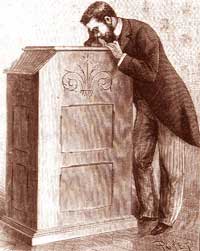Kinetoscope Crime Films
of G. W. "Billy" Bitzer & F. A. Dobson
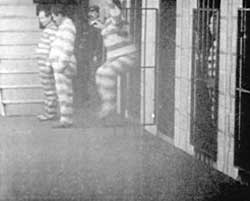 G. W. "Billy" Bitzer was one of the pioneers of crime cinema, having tackled such fiction in the kinetoscope era from the point of view of the absurd, as in Impossible Convicts (1905), to the deadly serious as in The Great Jewel Mystery; aka, The Mystery of the Missing Jewel Casket (1905).
G. W. "Billy" Bitzer was one of the pioneers of crime cinema, having tackled such fiction in the kinetoscope era from the point of view of the absurd, as in Impossible Convicts (1905), to the deadly serious as in The Great Jewel Mystery; aka, The Mystery of the Missing Jewel Casket (1905).
At first everyone walks backward in the odd wee under-three-minute prison comedy Impossible Convicts. But when they begin to escape everyone goes forward. Then everyone's loping backwards again & just going this way & that without purpose.
It concludes with two guards & two convicts wrestling on the floor & roling backward up the stairs. None of it makes sense & is only an absurdist jest allowing the G. W. Bitzer to experiment with trick photography.
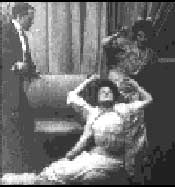 Under a minute, A Ballroom Tragedy (1905) is a highly condensed crime drama perhaps based on a play of the era, perhaps only the vaudeville vignette seen here.
Under a minute, A Ballroom Tragedy (1905) is a highly condensed crime drama perhaps based on a play of the era, perhaps only the vaudeville vignette seen here.
In a privately curtained sitting room, a man unfaithful to his lover is smooching with a new gal on a davenport.
It's hard to tell from the little film's context exclusively, but by the title & the Biograph catalog bulletin, we know this is a quiet room designed to get away from a larger parlor nearby where guests are dancing.
A second woman sneaks behind the curtains to spy on the doings of the man & his new girlfriend. When they kiss, the jealous woman, one of cinema's earliest femme fatales, raises a knife & kills her lover's new mistress.
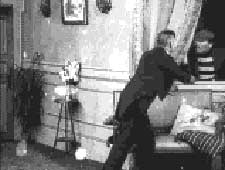 Another pioneer of crime cinema was F. A. Dobson, who worked with Billy Bitzer on The Great Jewel Mystery, besides films of his own like The Society Raffles (1905) & New York Skyscrapers (1905).
Another pioneer of crime cinema was F. A. Dobson, who worked with Billy Bitzer on The Great Jewel Mystery, besides films of his own like The Society Raffles (1905) & New York Skyscrapers (1905).
In Society Raffles a well dressed man investigates a sitting room, apparently glad there's no one present. He approaches an open window & signals a burglar, who leans into the room but doesn't enter.
A third man enters to introduce a wealthy matron to our well dressed thief, then leaves. The well dressed thief & the matron sit on a small couch in front of the window & he proceeds to woo her, while slipping her diamond tiara from her hair & handing it out the window to his partner.
The well dressed thief makes an excuse to leave the room. When the woman is alone, she spots the burglar at the window, grabs her hair, realizes she's been robbed of her tiara, & faints away.
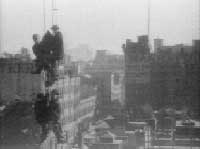 Fred Dobson also directed a more substantial crime drama The Skyscrapers of New York, aka, Skyscrapers about a fired worker who robs his former employer.
Fred Dobson also directed a more substantial crime drama The Skyscrapers of New York, aka, Skyscrapers about a fired worker who robs his former employer.
It begins in the style of a documentary about the laborers who built New York's skyline, opening with a panoramic shot of the city & settling on a group of laborers in the girters of an unfinished skyscraper including bricklayers, riviters, & so on, excellent on-location footage of the real deal with familiar city landmarks in the distance.
Men climbing, riding & maneuvering the girters is thrilling in & of itself. An terrifying scene shows a group of four men clinging to a crane cable to be lowered to the distant ground, waving enthusiastically at the camera.
It's obviously dangerous work & not an environment for causing trouble or losing one's temper. Nevertheless, the villain, "Dago Pete," starts a fight for no visible reasons (perhaps because everyone called him a Dago), & is in consequence fired.
In retribution, Pete robs the contractor, framing the foreman who fired him. The highlight of the tale is an action sequence of a fistfight high atop the skyscraper amidst the girters, with the foreman nearly killed.
It concludes with a court scene of Dago Pete giving false testimony against the foreman for theft, but he's exposed by a witness, the foreman's daughter, who saw Pete plant evidence in their house.
Fred Dobson & Billy Blitzer were close associates at the American Mutoscope & Biograph Company, & both were pioneers in the formation of a new crime cinema. They worked together on The Great Jewel Mystery, an eight minute film that manages to present a fairly elaborate jewel heist.
A coffin is loaded onto a rail car, the same as is transporting jewels. Instead of a corpse, however, the coffin contains one of the thieves. Slipping from the coffin, he attacks the guard, & hides the jewels in the coffin.
The Great Jewel Mystery takes its title cue from Edwin S. Porter's The Great Train Robbery (1903), & its train setting too. The story claimed to have been based on an unsolved heist that occurred on the railroad line between New York city & Newport. The film, however, does not permit the felons to get away with it.
copyright © by Paghat the Ratgirl
|
